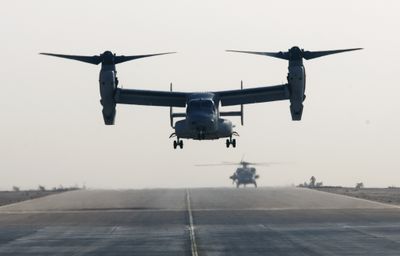Despite problems, Osprey will serve in Afghanistan

WASHINGTON – In the fall, the first squadron of Marines finally will fly V-22 Ospreys into the mountains of Afghanistan, months behind schedule and despite shortcomings that make some in Congress worry whether the hybrid aircraft can do the job for which it was intended.
The aircraft, which takes off and lands like a helicopter but flies like a plane, has numerous problems. Among them: Marines can’t fast-rope out the side door to land in hot zones. It can’t land without power – a key maneuver called autorotation that saved thousands of lives in Vietnam – without danger of flipping into its own downwash. It isn’t capable of maneuvering in combat conditions.
The aircraft also continues to struggle with reliability issues that made its mission capability far below expectations during three tours in Iraq and left Marines cannibalizing other Ospreys for spare parts, despite a price tag that’s climbed to $121 million apiece.
Rep. Edolphus Towns, D-N.Y., said at a hearing Tuesday that it was time to end the program. Towns is the chairman of the House Committee on Oversight and Government Reform, which has been studying the Osprey’s cost and mechanical problems.
“It can’t be used in hot weather. It can’t be used in cold weather. It can’t be used in sand,” Towns said. “The list of what the Osprey can’t do is longer than what it can do.”
The Government Accountability Office, a nonpartisan congressional agency that audits federal programs, reviewed the aircraft’s Iraq mission reports and concluded last month that the Marines ought to revisit the Osprey and look for alternatives.
At the congressional hearing Tuesday, the Marine Corps said it saw no reason to re-evaluate the struggling V-22 program.
Lt. Gen. George J. Trautman III, the Marines’ deputy commandant for aviation, said the Osprey was successfully flying high, far and fast across Iraq, carrying troops above the danger of small-arms fire and shrinking the battlefield.
In Afghanistan, Trautman said, “this aircraft will not just be a nice new capability. It will be a crucial, capable necessity that wins battles and saves lives.”
The V-22 Osprey, decades in development, was designed to replace helicopters that can date to the Vietnam War era. Military leaders wanted a nimble aircraft that offered distance and speed in addition to a helicopter’s agility. The Osprey has been plagued with problems, however.
Twenty-six Marines and four civilians have been killed in Osprey crashes since the 1990s. There were problems mounting a gun on the front of the Osprey. It couldn’t fly well at altitudes above 8,000 feet or in extreme heat. NASA experts told the Marines years ago that the aircraft had great difficulty landing on aircraft carriers in the rolling open seas.
With the 30-year program projected to cost nearly $75 billion, the GAO recommended a new analysis of the military’s needs. It found that in Iraq, the aircraft was capable of conducting missions less than two-thirds of the time because of weather obstacles or breakdowns.
Rep. Elijah Cummings, D-Md., asked why the military keeps defending the V-22 program rather than looking for ways to repair it.
“The reason we’re defending the program is because this airplane will save lives,” Trautman said. “It’s already demonstrated it’s saving lives.”
In Iraq, the Osprey has served largely as a VIP shuttle and troop transport. It ferried Sen. John McCain, R-Ariz., and then-Sen. Barack Obama across Iraq last fall during the presidential campaign.
“The Osprey can complete missions assigned in low-threat environments,” testified Michael Sullivan of the GAO. He was less confident about high-threat environments.
Col. Karsten Heckl, the commander of Marine Medium Tiltrotor Squadron 162 from New River, N.C., testified that he had never had problems finishing missions and that he had accompanied troops on raids into dangerous parts of the country.
“I’d fly this airplane in any environment,” Heckl said.